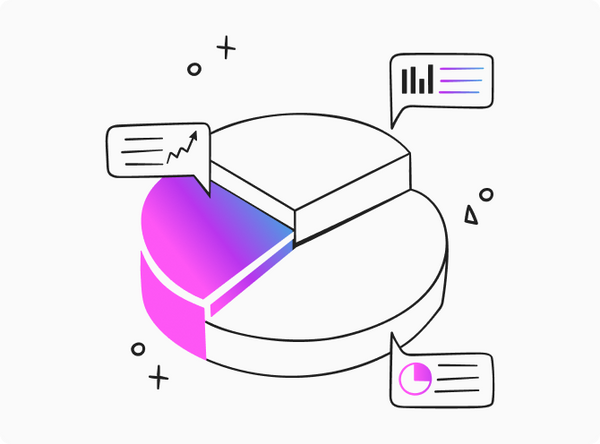
The mobile app industry is one of the most lucrative and fastest growing. According to Precedence Research, the global mobile app market is expected to surpass the $793 billion mark by 2030. It's no wonder so many companies are looking for opportunities in this niche.
Are you wondering how to make sure that your business model or idea will actually work? Is there any way to somehow test it and find out? The answer is ‘YES”, and you can do it with the help of an MVP. In today's post, we explain what the concept of an MVP is all about and why you need an MVP for your mobile app in the first place.
What Does MVP Stand for in Application Development
The acronym MVP stands for Minimum Viable Product. It is a product development strategy in which the very basic version of an app gets rolled out with only key features to meet the needs of the first users and get their feedback for future product updates.
How is this different from a fully-functional app?
The main difference between the MVP approach and the development of a fully fledged app lies in the fact that the MVP allows you to test the business idea without actually investing too many resources into product development. By doing so companies can greatly minimize potential risks and iterate faster.

Value and Benefits of MVPs for Your Mobile App Project
Cost-effective development
As already mentioned, creating MVP for applications involves building and launching the very basic version of your product with only essential features. This allows you to avoid spending time and resources on developing functionalities that may not be necessary or may not be well received by your target audience. This, in turn, reduces the overall costs needed for the development of an MVP.
Faster time to market
An MVP can also help to speed up the time to market for your product. You can quickly prototype and launch the app, without spending time on low-priority development activities. Such an approach would be especially helpful for small projects and those that have limited timeframes for the product launch.
Focus on core idea
MVPs help companies to focus on the core idea of their product. This is very important at the early stages of business development when you don't want to get bogged down in non-essential secondary activities, and also want to maximize the return on your investments.
In addition, an MVP can give you a more comprehensive and objective picture regarding the viability of your initial idea. For instance, you can assess the true potential of your concept before it takes a different form or gets modified during the development process.
Clear UI
In the same fashion as with the core concept of your app, an MVP allows you to come up with a clear and easy-to-navigate UI. This, in turn, allows developers to establish an intuitive user experience, engage users more effectively in the early stages, and reduce risks of frustration.
Allows to test customer demand
Oftentimes when creating a product you may not be sure whether the market can actually provide enough demand for it. This is where MVPs come in handy. They give businesses an opportunity to get feedback from early adopters, identify potential product flaws and weaknesses, and make improvements based on user feedback. It also, in the worst-case scenario, allows them to abandon the idea and close the project before investing top dollar in it.
Minimized risks
An MVP is the safest approach to app development as it helps you to literally reduce all possible risks. MVPs allow for quicker releases, don't require significant (relatively speaking) investments to be made, and can be developed by a small team. Plus, they work great for pitching your app concept to potential investors and allow you to come up with a marketable version of the product on budget.

How Long Does It Take to Build an MVP for Mobile Apps
The time it takes to build an MVP for a mobile app varies depending on several factors, such as the number of features, project complexity, development team experience, etc. In general, however, it can take anywhere from a few weeks to a few months to develop MVP for application.
It will obviously take less time to develop a bare-bones version of the app than a complex product with several integrations. In any case, when it comes to MVP app development, keep in mind that you should always stay within reasonable time frames, which is the whole point of the MVP concept — to launch fast without spending years on development.
How Much Does It Cost to Create an MVP App in 2023
The cost of creating MVP for mobile apps can vary greatly depending on similar factors — the complexity of the app, the platform it is developed for, the feature list, and whether you're developing your project with an in-house team or outsourcing it on-shore or off-shore.
In the US, for example, the development rates can go up to $300 per hour for companies that work with government and/or high-profile projects. In Europe, these rates may be 2-3 times lower. To give you a general perspective, though, the cost of developing an MVP app can range from $5,000 to $50,000 — all depending on the aforementioned factors.
To get a more accurate estimate, it's best to consult with a professional development team. They’ll be able to provide an estimate if you give them a detailed description of your app's features, functionalities, and goals.
MVP App Success Stories Examples
Let's now check some of the renowned names in the industry and mobile app MVP examples. They became highly successful through continued testing, iteration, and growth of their products.
Amazon
Amazon started as a small online bookstore platform back in 1994. Their initial version was a basic website that allowed users to order books online. Soon, the website gained traction and started to expand its offerings to include other products and services. Today, it is one of the largest online retailers in the world.
Zappos
The Zappos platform started as a kind of Wizard of Oz MVP back in 1999. Claiming to be a shoe retailer, they didn't actually have any stock and had to buy shoes from the local stores every time an order was placed on their website. As the platform grew, it expanded to offer clothing, accessories, home goods, and more. Now Zappos is known as one of the largest online shoe retailers in the world.
Airbnb
Airbnb was launched in 2008 as an MVP that allowed people to rent out their spare rooms or apartments. Initially, they were offering a few listings in San Francisco, but within a few years grew to become a global platform, with millions of listings in 190+ countries. Today, Airbnb has a valuation of over $80 billion.
Uber
Uber started in 2010 as a basic mobile app for luxury car service. The service connected riders with nearby drivers and was initially available in San Francisco only. As it expanded more and more, it started to include additional services, such as UberEats, Uber Rent, Uber Green, etc. Today, Uber is known as a global phenomenon whose offerings span across hundreds of cities worldwide.
Dropbox
Dropbox was launched in 2007 as a service that allowed users to store and share files in the cloud. The initial version was a simple MVP that synced files across multiple devices but it managed to generate significant interest — the number of users on the beta-testing list jumped from 5,000 to 75,000 almost overnight. With the right strategy and planning, Dropbox grew into a popular file-sharing tool that today has a valuation of over $10 billion.
How to Build an MVP That Attracts Users
Define a problem you're going to address
The first step in creating an MVP is to identify a problem that you can address with your app. Take the time to research the issue and understand it from the perspective of potential customers. What pain points are they experiencing? What needs are not currently being met?
When defining the problem, it’s important to ensure that it’s something that can be solved with your app. Focus on those problems that are actually manageable — technically and practically speaking.
Validate it
Once you’ve identified the problem, it’s important to validate it. In other words, you need to ensure that your findings about the market match the actual demand. This can be done by conducting surveys and interviews with the target audience to gain insights and understand whether your idea has value to them.
Study competitors
The next step is to study your competitors. What are they doing that’s working? What can your MVP do differently to stand out? Are there any features that are missing that you can capitalize on?
This research will help you understand the current market landscape and identify unique opportunities — or value — that you can offer to your users to move ahead of the competition.
Aside from product features, also study the pricing and marketing efforts of your competitors. Try to analyze what works and why, which tactics could your project adopt or avoid, etc.
Prioritize core features
Most startups begin with a limited amount of resources. If your company is one of those, you want to make sure that the budget you allocate for the project is used as effectively as possible.
Prioritizing features helps you focus on the most important and valuable features that can, on one hand, be the most beneficial for your target audience, and on the other help you achieve projected goals and not fail.
By focusing on the most important features, you can avoid wasting resources on less critical aspects of your MVP, and release your product faster. For more on how to prioritize MVP functionality read this article.
Build a team
Building an MVP requires the right team of experts. You can actually build an in-house team or opt to outsource it with a software development company. Each approach has its own advantages.
With an in-house team, for example, you get the most control over your project. However, this development strategy is the hardest one to get off the ground. Not only will you need to assemble the team, but you'll also have to manage the project yourself, account for all the expenses, and so on.
Partnering with an outsourcing company can take that burden of ongoing recruitment and management off your shoulders, allowing you to concentrate on the strategic decisions while leaving all the operational and development activities to your outsourcing partner.
Develop and launch an MVP
Once you've gathered — or partnered with — a professional development team, you are ready to proceed to the technical part of the process and create an MVP. After that, launch your MVP in the market to get feedback from a wider audience.
Track user engagement, user retention, experience, and other performance indicators to assess the MVP's viability in the market. Also, gather user feedback directly to get an idea of what they feel about your product, what improvements should be made to it, and so on.
Remember that an MVP is not a final product but a starting point that will help you validate your app idea. So, after your mobile app MVP goes live, keep iterating and improving it based on the information you get from your target audience.

Consider Lunka.tech Your Trusted Partner
At Lunka.tech we believe that software development is not just about writing code. It's about understanding project needs and creating custom solutions that help clients achieve their business goals. Our team is composed of experienced software developers who are dedicated to delivering innovative digital solutions.
We have extensive technical expertise in web and mobile app development and UI/UX, and are able to deliver end-to-end services to your project — including support and maintenance. We work with businesses of all sizes, from startups and SMEs to large enterprises. We are ready to step up to any challenge no matter the complexity.
In our work, we follow agile methodologies which allow us to deliver projects quickly and efficiently while maintaining high quality. Check out our portfolio that showcases MVP examples for a mobile app and also encompasses projects of different niches, sizes, and types.

Final Thoughts
The development of an MVP brings a lot of benefits to the table. It allows companies to build a functional app quickly and in a cost-effective manner, focusing on the core business concept and effective UI. MVPs also minimize risks and help to get user feedback quickly.
This approach works especially well for startups whose resources are limited, but who need to get a marketable product that they can present to their audiences. Thus, if you’re looking for a cost-effective and efficient way to get your mobile app off the ground, an MVP would be your best option.
For more information on how to build MVP for mobile apps or how much does mobile app MVP cost feel free to reach our dedicated team in the most convenient way to you — via phone, email, or a feedback form.
FAQ
What does MVP stand for in app development?
MVP or Minimum Viable Product is the basic version of a product that includes only the essential features necessary to deliver value to the end users. It is normally developed to test the product's viability and the potential demand for it in the market.
How much does it cost to make an MVP for applications?
The cost of creating MVP for applications can vary depending on such factors as the complexity of the app, the platform(s) it is intended for, the features, and the type of development approach; in-house or outsourced. In rough numbers, we're talking a range from $5,000 to $50,000. However, these are for informational purposes only. For a more accurate estimate of how much your MVP might cost, contact our managers.
Can I build a mobile app MVP myself?
It’s absolutely possible if you have some experience with similar projects and have a reliable development team that can carry out the project for you. In all other cases, we strongly recommend seeking professional help when building an MVP for mobile applications.
Should an MVP be scalable?
Yes, an MVP should absolutely be scalable, and it's better to plan for its scalability beforehand so that once it gets released you already know what your future steps are going to be. If you're wondering what comes after your MVP is ready, make sure to check our article.


